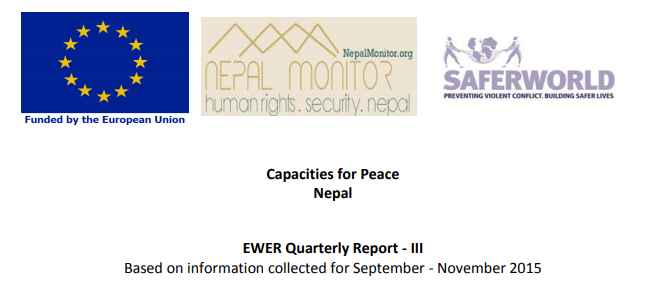Analysis
Third EWER Quarterly Report September-November 2015
2016-02-21

This report has been prepared by SaferWorld’s Capacities for Peace (C4P) project supported by European Union. This is a third edition of the report which is published in collaboration of NepalMonitor.org and SaferWorld on a quarterly basis.
This report provides an overview of the situation of civil rights, the possible sources of conflict and ways to mitigate them in Nepal for the period from 1 September 2015 through the end of November 2015. It is prepared on the basis of information provided by five civil society representatives from the five development regions of Nepal. Information was gathered under the headings of Governance, Social Cohesion/Tension, Political Tensions/Mobilization Resource Conflicts, Transitional Justice/Access to Justice, Post-earthquake aid distribution and recovery-related tensions/conflicts, and Trends. The information received under these headings has been analyzed and the findings are presented in the following report.
In addition to publishing the quarterly report on Nepal Monitor’s blog, it is also distributed to national and international organizations which work in Nepal in the field of peace, security and human rights.
Summary findings:
- Due to strikes and bandas called by political parties, public access to administrative services was affected and citizens were not able to receive said services. Similarly, obstruction created by United Democratic Madheshi Front (UDMF)’s sit-in program along the Indo-Nepal border entry points and the blockade was also found to affect access to services.
- Impunity and patriarchal social norms hindered an effective fight against incidents of discrimination and violence against women. Thus, cases of physical and sexual violence against women and children continued to be reported for the period under review. There were also some cases of ill-treatment against women for allegedly practicing ‘witchcraft’.
- Similar to previous reports, caste-based discrimination and the issue of ‘untouchability’ were still prevalent. In particular, some Dalits were discriminated against; as a result they were treated poorly and in some instances humiliated publicly.
- Public opinion was highly divided in regard to political strikes and agitations in the Madhes, protests and the obstruction at border check-points. An undercurrent of bitterness is reported to have developed within the community as a result. Public debate was polarized either for or against these political activities. However social relations among various groups remained largely amicable. Some attempts for maintaining social harmony were also observed.
- As previously reported, violence in the Terai increased in the context of the movement called by UDMF and the state’s response, resulting in death, serious injuries to demonstrators, and damage of physical property during this period.
- Many victims of the armed conflict were found to have received partial relief, though some have yet to receive any at all. However their hope for justice still prevails despite relative inaction of state authorities to address their problems.
- Though earthquake-affected survivors received immediate relief, many are yet to receive short-term and long-term relief. Survivors suffering from the risks associated with rain, hailstones, landslides, etc. during the monsoon season were facing problems such as lack of warm clothes and food, among other things, with the start of winter.

